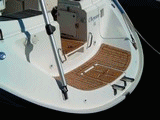


|
The cork oak The cork oak - Quercus Suber L - appeared more than 60 million years ago, in the Western Mediterranean . The exploration of this resource is an excellent example of the relationship between Man and Earth, and the respect for the ecological model. Cork , the bark of the cork oak, is a vegetative material, composed of micro cells, which are generally of polyhedric form. The intercellular spaces are filled with a gas composition, identical to that of air. The special characteristics of cork and its multiple applications are due to the honeycomb structure and the nature of the cellular membranes. Lightweight, resistant to wear, impermeable, elastic but of stable size, cork has a perfect capacity for heat insulation and vibration dampening. It has been used in the manufacture of many products, for thousands of years. The work of cork The barking season lasts from July, through to September.
The turning point for the cork industry took place in the second half of the XVIIe century. The galleons of XVIe century, who ventured into unexplored seas, were known as "the cork galleons", so large was the quantity of bonds, benches, trunks, bowls, mess tins, shoes and other objects carved from cork bark. It was D. Pierre Pérignon, head wine waiter at the abbey of Hautvillers, who first adopted cork as a stopper for the sparkling wine bottles of the Champagne area. The cork stopper then flourished with its incomparable capacity to preserve the quality of wine. Chemical composition 45% Suberin : a complex fatty acid, and the principal component of cork, responsible for its elasticity. 27% Lignin : An integral part of the cell walls of Cork . 12% Polysaccharides : The part contributing to the texture of cork. 6% Tanins : Determining its characteristic colour. 5% Céroïdes : The hydrophobic part which helps to ensure its impermeability. 5% Various : Minerals, water, glycerin and other
|
|

